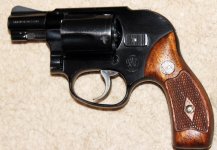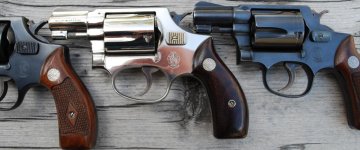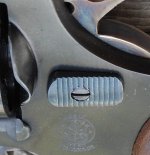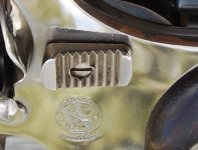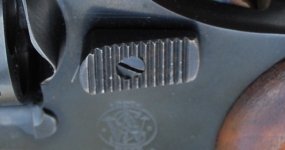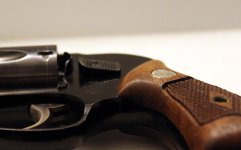You are using an out of date browser. It may not display this or other websites correctly.
You should upgrade or use an alternative browser.
You should upgrade or use an alternative browser.
Question on Flat Latch
- Thread starter Vettepartz
- Start date
Register to hide this ad
jsfricks
Member
Hondo44 use to have pictures on the forum in different threads of the three different flat latches, but they went away with Photobucket. Hopefully he'll see this thread.
Looks like the first style to me. I think the other two had an elevated forward end...sorta wedge shaped, but I'm not up on these. Hondo44 will be along and quote you the book on these. Or you can do a forum search because he has esplained it before several times, IIRC.
black88is
Member
Thats a second, it is elevated slightly and not round on horizontal edges.
I believe your nice looking Bodyguard has the 3rd style flat latch. I'm guessing it shipped in 1956.
Here are photos of three of my Chiefs Specials with the three flat latch styles. The photos with all three versions show the 3rd, 2nd and 1st in left-to-right order, and the individual photo titles show the years these guns shipped from the factory in parentheses. You can see the 2nd style has 7 ridges, and the 3rd style has 11 (Hondo44 can probably tell us if those numbers of ridges are consistent through each latch style's lifetime). Sorry I can't help with sn ranges for each style.
The SCSW 4th edition says the Bodyguards were produced with "flat latch thumbpieces in three variations," but I doubt that. My 1955 Chiefs Special is sn 59221, and it has the 3rd style flat latch. The SCSW lists the first Bodyguard in sn range beginning with 66000 (same sn range as the Chiefs Specials).
Hope this helps,
Bob
Here are photos of three of my Chiefs Specials with the three flat latch styles. The photos with all three versions show the 3rd, 2nd and 1st in left-to-right order, and the individual photo titles show the years these guns shipped from the factory in parentheses. You can see the 2nd style has 7 ridges, and the 3rd style has 11 (Hondo44 can probably tell us if those numbers of ridges are consistent through each latch style's lifetime). Sorry I can't help with sn ranges for each style.
The SCSW 4th edition says the Bodyguards were produced with "flat latch thumbpieces in three variations," but I doubt that. My 1955 Chiefs Special is sn 59221, and it has the 3rd style flat latch. The SCSW lists the first Bodyguard in sn range beginning with 66000 (same sn range as the Chiefs Specials).
Hope this helps,
Bob
Attachments
Thanks Bob!
Exactly right, great photos too.
2nd style has less ramp shape from the side view, larger flats at both ends and the least # of grooves.
3rd style side view shows more extreme ramp shape:

Photo by Watchdog
Also right about the 1st style flat latch: it was gone by the time the other J frame versions (BodyGuard, Centennial, and Model of 1955 22/32 Kit Gun Airweight) were introduced.
GENERAL BACKGROUND OF FLAT LATCHES USAGE:
The 1st style flat latch began exclusively on the Baby J frame but not with #1; (earliest known #111 presented by S&W to Col. Rex Applegate), used on most all after ~ #117 beginning in very late 1950. The only other model to have used the 1st style was the alloy K frame, not on any other J frame or the I frame models. It was gone by the time the other J frame versions (BodyGuard, Centennial, and Model of 1955 22/32 Kit Gun Airweight) were introduced.
A transition to the 2nd style flat latch began on the Baby J frame 2nd Variation (ramp sight and barrel rib) above the #25,000 range in 1953.
The I frames used all four styles of the standard thumb piece before beginning use of the flat latch, starting with the Improved (coil mainspring) I frame - 2nd Variation (ramp sight and barrel rib) in 1953; above # 60430X on the .32 I frames, and at around # 747XX on the.38 S&W .38/32 I frames.
There are no Improved I frame .22/32s neither 1st or 2nd Variations; so for the .22/32s, the coil spring and 2nd style flat latch began with the Model of 1953 New I frame which also began a new serial # range beginning with #100.
All other Models of 1953 New I frames and New J frames were introduced using the 2nd style flat latch.
The Kit Gun Airweight (Pre model 43) was introduced with the 2nd style in 1955 which began with #5000 in the Kit Gun serial # range.
A transition to the 3rd style flat latch began in the late 1956 period for all I and J frames until discontinued on all models in 1966.
Exactly right, great photos too.
2nd style has less ramp shape from the side view, larger flats at both ends and the least # of grooves.
3rd style side view shows more extreme ramp shape:

Photo by Watchdog
Also right about the 1st style flat latch: it was gone by the time the other J frame versions (BodyGuard, Centennial, and Model of 1955 22/32 Kit Gun Airweight) were introduced.
GENERAL BACKGROUND OF FLAT LATCHES USAGE:
The 1st style flat latch began exclusively on the Baby J frame but not with #1; (earliest known #111 presented by S&W to Col. Rex Applegate), used on most all after ~ #117 beginning in very late 1950. The only other model to have used the 1st style was the alloy K frame, not on any other J frame or the I frame models. It was gone by the time the other J frame versions (BodyGuard, Centennial, and Model of 1955 22/32 Kit Gun Airweight) were introduced.
A transition to the 2nd style flat latch began on the Baby J frame 2nd Variation (ramp sight and barrel rib) above the #25,000 range in 1953.
The I frames used all four styles of the standard thumb piece before beginning use of the flat latch, starting with the Improved (coil mainspring) I frame - 2nd Variation (ramp sight and barrel rib) in 1953; above # 60430X on the .32 I frames, and at around # 747XX on the.38 S&W .38/32 I frames.
There are no Improved I frame .22/32s neither 1st or 2nd Variations; so for the .22/32s, the coil spring and 2nd style flat latch began with the Model of 1953 New I frame which also began a new serial # range beginning with #100.
All other Models of 1953 New I frames and New J frames were introduced using the 2nd style flat latch.
The Kit Gun Airweight (Pre model 43) was introduced with the 2nd style in 1955 which began with #5000 in the Kit Gun serial # range.
A transition to the 3rd style flat latch began in the late 1956 period for all I and J frames until discontinued on all models in 1966.
Last edited:
Very nice pics and helpful posting...thanks!
I believe your nice looking Bodyguard has the 3rd style flat latch. I'm guessing it shipped in 1956.
Here are photos of three of my Chiefs Specials with the three flat latch styles. The photos with all three versions show the 3rd, 2nd and 1st in left-to-right order, and the individual photo titles show the years these guns shipped from the factory in parentheses. You can see the 2nd style has 7 ridges, and the 3rd style has 11 (Hondo44 can probably tell us if those numbers of ridges are consistent through each latch style's lifetime). Sorry I can't help with sn ranges for each style.
The SCSW 4th edition says the Bodyguards were produced with "flat latch thumbpieces in three variations," but I doubt that. My 1955 Chiefs Special is sn 59221, and it has the 3rd style flat latch. The SCSW lists the first Bodyguard in sn range beginning with 66000 (same sn range as the Chiefs Specials).
Hope this helps,
Bob
Bob,
To answer your question about the # of ridges in the 2nd style flat latch:
All photos I've seen and all guns I own have 11 ridges, the same as the 1st and 3rd styles. Yours is the only one I've seen with only 7 ridges; perhaps a very early version of the 2nd style.
To answer your question about the # of ridges in the 2nd style flat latch:
All photos I've seen and all guns I own have 11 ridges, the same as the 1st and 3rd styles. Yours is the only one I've seen with only 7 ridges; perhaps a very early version of the 2nd style.
Last edited:
Original Poster here. First off, thanks to all for providing this information. It is very helpful. I think mine is the third style, and I believe the gun to be early 1956.
I gave the incorrect serial number in my first post. It actually is 73933. The SCSW (page 152) says a 1950's-era source reports the first production gun as serial 73780 manufactured in 12/16/1955. Since mine is only 153 numbers newer and is a 3 screw, I am thinking early 1956.
I gave the incorrect serial number in my first post. It actually is 73933. The SCSW (page 152) says a 1950's-era source reports the first production gun as serial 73780 manufactured in 12/16/1955. Since mine is only 153 numbers newer and is a 3 screw, I am thinking early 1956.
Attachments
All photos I've seen and all guns I own have 11 ridges, the same as the 1st and 3rd styles. Yours is the only one I've seen with only 7 ridges; perhaps a very early version of the 2nd style.
Thanks Jim. This little nickel cutie just keeps surprising me. Here's what you said about it on a separate thread:
Your #47475 is the earliest Model of 1953 of any in my database. It even has the Baby Chief old style hammer! Very likely an early 1954 ship date.
I'm thinking this suggests a letter is in order. Would you agree?
OP:
Thank you for the detailed sn info. You highlight an interesting point. The SCSW 4th (p. 178) says the Bodyguard was "... built on the round butt alloy J frame with 4 screws." I've not seen a Bodyguard with 4 screws; has anyone else seen one?
Cheers,
Bob
Original Poster here. First off, thanks to all for providing this information. It is very helpful. I think mine is the third style, and I believe the gun to be early 1956.
I gave the incorrect serial number in my first post. It actually is 73933. The SCSW (page 152) says a 1950's-era source reports the first production gun as serial 73780 manufactured in 12/16/1955. Since mine is only 153 numbers newer and is a 3 screw, I am thinking early 1956.
• Eliminate upper side plate screw change order 12/13/55, the 4th screw on New I & New J frames.
Usually took several months for the change to show up on the guns so it may be later in '56 especially since, I agree it does have the 3rd style flat latch. But we never know with S&W w/o a letter.
I confused the issue -- here's the clarification
Hondo44, Vettepartz, et al,
I made a mistake in my first post here.
By studying Hondo44's chronology I found my error.
The 1955 Chiefs Special I said had the 3rd style flat latch really doesn't. It has a 2nd style. I pulled out my next newest Chiefs (a 1959 Model 36) removed the latches and shot this image. On the left is the latch from the 1955 Chiefs and the one from the 1959 Model 36 is on the right. I had allowed that nickel 7-ridge latch fool me into believing that was the standard for the 2nd style latch.
Hope I've gotten this right, this time. Or, on the other hand, do we really have 4 flat latch styles (the 7-ridge version on my nickel Chiefs actually being the 2nd style)?
Bob
Hondo44, Vettepartz, et al,
I made a mistake in my first post here.
By studying Hondo44's chronology I found my error.
A transition to the 3rd style flat latch began in the late 1956 period for all I and J frames....
The 1955 Chiefs Special I said had the 3rd style flat latch really doesn't. It has a 2nd style. I pulled out my next newest Chiefs (a 1959 Model 36) removed the latches and shot this image. On the left is the latch from the 1955 Chiefs and the one from the 1959 Model 36 is on the right. I had allowed that nickel 7-ridge latch fool me into believing that was the standard for the 2nd style latch.
Hope I've gotten this right, this time. Or, on the other hand, do we really have 4 flat latch styles (the 7-ridge version on my nickel Chiefs actually being the 2nd style)?
Bob
Attachments
Bob, 47475 is definitely a unique version.
Unfortunately, a letter would not go into detail about the flat latch and likely may not even mention it. I'd still letter it however.
I don't recall seeing a 4 screw Bodyguard although I have never looked for that specifically. But both the SCSW and History of S&W by Roy Jinks pg 230 clearly states they did. The timing of the early production certainly suggests they exist.
Unfortunately, a letter would not go into detail about the flat latch and likely may not even mention it. I'd still letter it however.
I don't recall seeing a 4 screw Bodyguard although I have never looked for that specifically. But both the SCSW and History of S&W by Roy Jinks pg 230 clearly states they did. The timing of the early production certainly suggests they exist.
Last edited:
Hondo44, Vettepartz, et al,
I made a mistake in my first post here.
By studying Hondo44's chronology I found my error.
The 1955 Chiefs Special I said had the 3rd style flat latch really doesn't. It has a 2nd style. I pulled out my next newest Chiefs (a 1959 Model 36) removed the latches and shot this image. On the left is the latch from the 1955 Chiefs and the one from the 1959 Model 36 is on the right. I had allowed that nickel 7-ridge latch fool me into believing that was the standard for the 2nd style latch.
Hope I've gotten this right, this time. Or, on the other hand, do we really have 4 flat latch styles (the 7-ridge version on my nickel Chiefs actually being the 2nd style)?
Bob
You may be on to something!! I recall seeing 2nd types with larger flats on each end like your '7 ridge', but never counted the ridges.
We'll have to be on the look out from now on. Or you may want to start a new thread entitled "Anyone have a flat latch like this on a mid '50s I or J frame?"
Last edited:
elm_creek_smith
US Veteran
Here's another "flat latch." This is on my 1963-vintage Model 12-2 Airweight K-frame. Pardon the dust, but this is my primary carry gun off duty.


Sent from my QTAQZ3 using Tapatalk


Sent from my QTAQZ3 using Tapatalk
Thats a second, it is elevated slightly and not round on horizontal edges.
After further study I have to agree with this! Good eye, black88is.
Similar threads
- Replies
- 20
- Views
- 639
- Replies
- 4
- Views
- 615

